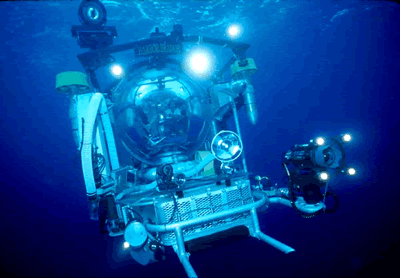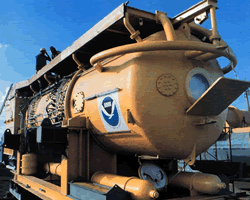Careers and Technology
Career Profiles
Unlock secrets in the deep oceans, track rapidly moving storms, operate state-of-the-art environmental satellites, chart the Nation's waterways, formulate models to forecast climate trends, protect and preserve our living marine resources. It's all in a day's work at the National Oceanic and Atmospheric Administration! At NOAA, a career can make a world of difference!

Copyright Harbor Branch Oceanographic Institution
Careers
A career with NOAA could launch you all over the world, from the warm waters of the Caribbean to the winter wonders of the South Pole. The challenges are endless. Employment in NOAA is a job with a mission. At NOAA, safeguarding the public, protecting natural resources, strengthening the economy. It's all in a day's work. Imagine yourself. Careers in NOAA are as diverse as the line offices that make up the agency. More information can be found on the Office of Workforce Management website.
Technology
We’ve come a long way since 1970, when NOAA was officially recognized and all of our components united under a common name and mission. The past 40 years have brought dramatic changes in almost every aspect of our lives—personal, professional, and civic. This era saw the end of the Cold War; the birth of the microcomputer, the Internet, and instant communications; the start of the environmental movement; and the development of a deeper understanding of our universe, our Earth, and our biological selves. Several of these “revolutions” had profound effects on NOAA.
Some changes within NOAA have been spurred by technological advances outside of the agency. Increasingly fast and powerful computer systems have allowed us to create more sophisticated computer simulations, or models. Scientists can now incorporate much more sophisticated data and information into models, better describing the natural environment. This new generation of models has markedly improved weather forecasts and increased our understanding of atmospheric and ocean climates.
It has really only been within the last 50 years that technology has advanced to the point that we can examine the oceans in systematic, scientific, and, most importantly, noninvasive ways. For the first time, our ability to observe the ocean environment and its resident creatures has finally caught up with our imagination. Numerous vessels, submersibles, diving technologies, and observation tools make ocean exploration possible.
Moreover, the advent of the Internet provided NOAA the opportunity to make a quantum leap in the way we provide information and data to the public—one of our core missions. Today, over 800 NOAA Web sites stream our vast data holdings nonstop throughout the world. These Web sites also serve to educate and inspire people young and old, offering everyone opportunities to explore with us underwater treasures, coastal habitats, and marine life.
Adapted from materials provided by NOAA Workforce Management, NOAA Celebrates 200 Years... and NOAA Ocean Explorer
Features

Chasing Bad Weather, Tracking Bad Air: The Answer Is Blowing in the Wind
2007 (NOAA Celebrates 200 Years)
Hurricane hunters, tornado chasers, cloud watchers, trace-gas tracers, model makers, remote-sensor designers, lab laborers—NOAA researchers are called many things...
Read More

The Aquarius Underwater Laboratory: America's "Inner Space" Station
(Ocean Exploration)
The Aquarius is the only undersea laboratory dedicated to marine science operating in the world. Owned by the National Oceanic and Atmospheric Administration (NOAA) and managed by the University...
Read More

Tracking Greenhouse Gases from NOAA’s Tall Towers
(NOAA News)
NOAA Earth System Research Laboratory (ESRL) scientist Dan Wolfe dons his safety hat and climbing harness before boarding the two-person elevator for the long, five-minute ride to the top...
Read More
